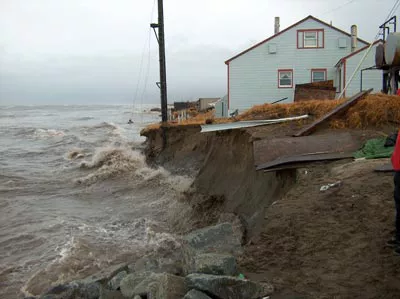Why does it matter if the Arctic sea ice melts? We often hear about the global consequences: waning sea ice is expected to lead to even more climate warming. On a more immediate and local level, the loss of summer sea ice is already affecting the land and people near the Arctic Ocean. As the ice melts to reveal the open ocean underneath, fragile coastlines become vulnerable to bigger waves and storms.
Like a layer of plastic wrap covering a bowl of soup, Arctic sea ice keeps the churning ocean underneath it from splashing up against the coast. A thick layer of sea ice absorbs the power of big waves, preventing them from slamming into beaches and sea cliffs. But as the ice melts, the ocean has started to tear away at coastlines and to flood seaside villages. Warmer temperatures in the Arctic are also thawing the permafrost, turning once frozen-solid land into soft, wet soil that crumbles easily. Recent reports confirm that thawing permafrost and sea ice loss are speeding up erosion along the Arctic coast.
The 2010 State of the Arctic Coasts report cited record warming, sea level rise, retreating sea ice, and thawing permafrost as a few of many threats to fragile Arctic coastlines. Another study issued this April measured varying erosion rates along the entire Arctic coastline for the first time. The worst-hit areas are retreating by as much as ten meters (thirty feet) per year.
Permafrost expert Hugues Lantuit worked on both reports, which measured about 100,000 kilometers of coastline. He said that some of those coastlines are remaining stable, but others are retreating faster and faster, driven by a troublesome combination of factors. As sea ice forms later in the season, a coastal area might see open water for a few more weeks in the fall. Lantuit said, “The strongest storms happen around that time, at the beginning of sea ice freeze-up.” Warmer waters can also help thaw coastlines that are made up of permafrost.
So what can coastal people do about the encroaching ocean? Some Arctic villages are trying to protect their homes with new sea walls or other methods to hold back the invading waters. In other places, people have decided to move. For example, the Yup’ik village of Newtok, located on the Yukon River Delta on the Alaskan coast, wants to move the entire village nine miles inland to a more protected spot. The village has been working for almost ten years to find a way to pay for the move.
References
Lantuit, H., Overduin, P. P., Couture, N., Wetterich, S., Are, F., Atkinson, D., Brown, J., Cherkashov, G., Drozdov, D., Forbes, D., Graves-Gaylord, A., Grigoriev, M., Hubberten, H.-W., Jordan, J., Jorgenson, T., Ødegård, R. S., Ogorodov, S., Pollard, W., Rachold, V., Sedenko, S., Solomon, S., Steenhuisen, F., Streletskaya, I., Vasiliev, A. 2011. The Arctic Coastal Dynamics database. A new classification scheme and statistics on arctic permafrost coastlines, Estuaries and Coasts, doi:10.1007/s12237-010-9362-6 .
Forbes, D.L. (editor). 2011. State of the Arctic Coast 2010 – Scientific Review and Outlook. International Arctic Science Committee, Land-Ocean Interactions in the Coastal Zone, Arctic Monitoring and Assessment Programme, International Permafrost Association. Helmholtz-Zentrum, Geesthacht, Germany, 178 p. http://arcticcoasts.org/

